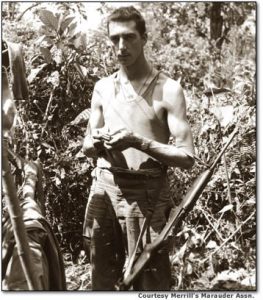M1 Carbine
M1 Carbine (and variants)
M1 Carbine (and variants)
The M1 Carbine was originally designed to meet the Army’s requirement for a lighter rifle. It was adopted by the US Army and entered into service during WWII. It was used by Rangers through the end of the war, as well as Korea and Vietnam. Over six million of the M1 and its variants, the M1A1, the M2, and the M3 were eventually made. The turning bolt is similar to a scaled down version of the rugged M1 Garand. The return system uses gas tapped into a chamber below the barrel. The M1 Carbine fires the same caliber round as the M1 Garand, although it uses a smaller pistol-type round than the Garand. The two types of ammunition are not interchangeable. A major advantage of the M1 Carbine over the Garand is that the Carbine uses a 15 or 30 round detachable magazine, whereas the Garand uses an eight-round en bloc clip. This feature, plus its lighter weight, made it ideal for jungle operations by the Marauders in Burma and by Rangers during the early Vietnam years.
- The M1A1 is the same as the M1, but is fitted with a folding stock and pistol-grip for paratroopers. There is even a belt-mounted holster available with this model.
- The M-2 has a selector lever on the left side of the receiver that allows for full automatic firing. This version was preferred by Ranger Company team leaders during the Korean War.
- The M-3 is the same as the M2 but allows for mounting a scope.
- All models can be fitted with a grenade launcher or bayonet.
- The M1 Carbine can still be found in virtually any small country.

Manufacturer Winchester Repeating Arms
Company and others
Caliber .30-06
Length 43.5 in
Weight 5 lbs 7 oz
Effective Range 300 m
Operation Gas
Muzzle Velocity 855 m/sec
Sight Front – blade with protecting ears
Rear – aperture
Magazine 15 or 30 round box type
Cyclic Rate 750 rpm

by Tim Davis
